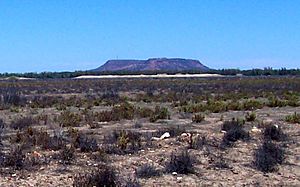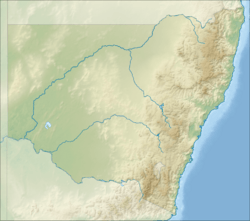Mount Oxley (New South Wales) facts for kids
Quick facts for kids Mount Oxley |
|
|---|---|
| Aboriginal: Oombi Oombi | |
 |
|
| Highest point | |
| Elevation | 307 m (1,007 ft) |
| Geography | |
| Location | Far West region of New South Wales in outback Australia |
| Country | Australia |
| State | nsw |
| Geology | |
| Age of rock | Cretaceous |
| Mountain type | Sedimentary |
Mount Oxley, also known as Oombi Oombi by Indigenous Australians, is a hill in the outback of New South Wales, Australia. It's about 32 kilometers (20 miles) from the town of Bourke.
This hill looks like a flat-topped mountain called a mesa, standing about 150 meters (490 feet) above the flat plains around it. It's what's left of a much bigger rock formation that has mostly worn away over time. The rocks here are mainly sandstone and quartzite.
The first European explorer to see Mount Oxley was Charles Sturt in December 1828. He wrote about hearing a loud noise, like a 'gun discharge,' near the mountain. He thought it might have been a natural gas explosion.
What's in a Name? The Story of Mount Oxley
Mount Oxley is named after the explorer John Oxley. However, its original name from the Indigenous Australians is Oombi Oombi.
Archaeological finds show that Aboriginal people used to get special stones from this area. These stones were highly valued for making grinding tools. Elders in the community carefully managed who could use these important stone resources.
Plants and Animals: Life at Mount Oxley
The plants growing on Mount Oxley have learned to live in a semi-arid climate, which means it's often dry. You can find different types of Acacia trees here. Other trees include the desert bloodwood, weeping pittosporum, and leopardwood.
After it rains, many colorful wildflowers from the daisy family bloom. Animals you might spot include western grey kangaroos and feral goats. Look up, and you might see Wedge-tailed eagles soaring high above the mountain.
The Geology of Mount Oxley's Unique Features
On top of Mount Oxley, you can see several small, round rock formations that look a bit like craters. These are arranged in two clear lines. Scientists and explorers have wondered for a long time how these formations were made.
The most likely idea is that they were formed by natural geological processes. Some people have suggested other ideas, like meteor impacts or even ancient explosions.
When Charles Sturt and his team visited in January 1828, they described these interesting hollows. They noted that the hollows were deeper in the middle and contained clean, flat pieces of sandstone. These pieces looked as if they had been perfectly cut. Sturt thought these hollows might have been formed by swirling water.
Mount Oxley has also been considered as a possible location for a wind farm. This would involve building several large wind turbines to create electricity.


